The PRINTABLE Guide to How to Use Essential Oils Safely
This post may contain affiliate links, including those from Amazon.com, which means we earn a small commission off your purchases. And here's the thing: We only mention services and products that we think are truly worth your attention, whether they're free, paid, or otherwise. This site relies on YOUR trust, so if we don't stand behind a product 110%, it's not mentioned. Period.
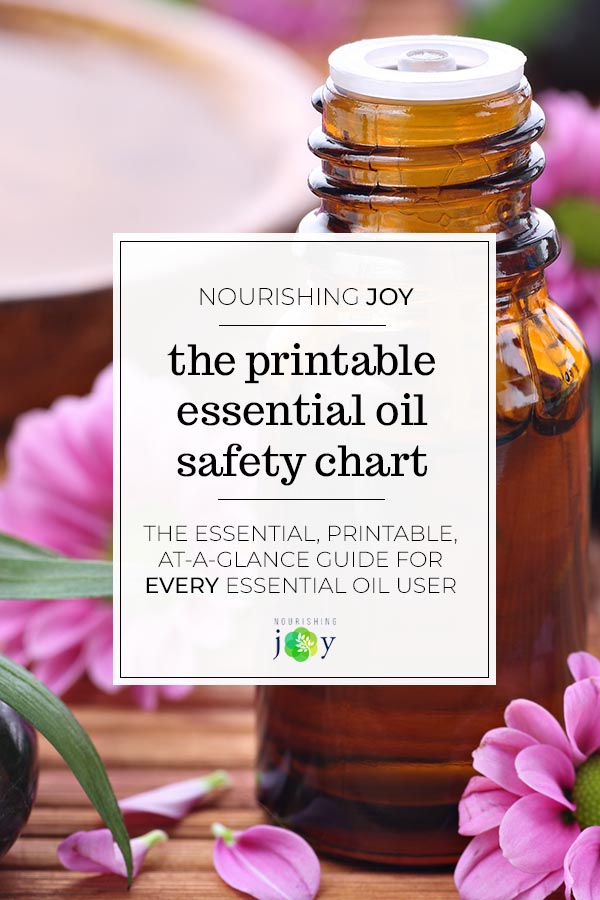


If you use or have researched essential oils at all in the last couple of years, you've noticed that everyone is talking about essential oils.
By and large, this is wonderful, as essential oils are the pharmaceutical-grade medicines of the natural world and when distilled well, are powerfully potent remedies. They're often touted for their strong antiviral, antibacterial, antimicrobial, and antifungal properties, which again, by and large is true.
However, you've likely also noticed that advice about essential oils is quite freely dispensed – some from highly knowledgeable sources and some from, well… we'll just say… vocal… sources.
So, as I myself have collected information with which to make decisions on how to use essential oils in our OWN home, I have stuffed a notebook full of print-outs and notes and torn scraps of paper. After five years, I figured it's time to compile the information into one concise reference. The result is the printable infographic below. 🙂
We've now got a HUGE resource outlining Safe Essential Oils for Babies & Children.
It includes a searchable database, an at-a-glance list of which oils are safe at which age, where to find ethical sources, and what each oil is good for (even for adults).
See the Safe Essential Oils for Babies & Children guide here.
The biggest area of concern for me with essential oils is that my family knows how to use them safely. Essential oils are highly concentrated and can have a dramatic effect on the body, mind, and spirit. And just because essential oils are natural doesn't mean they're inherently safe. Essential oils should be used carefully, with proper education, and in their proper amounts. It is SO easy to overdose essential oils!
In our family, we most often use them topically for sore muscles and the like, including Mommypotamus' fantastic chest rub, but as you've likely noticed in my recipes through the last few years, I also include them in personal care and cleaning recipes, including laundry detergent, burn cream, deodorant, shampoo, and even occasionally in squeezable homemade children's toothpaste and crayons.
Also, I highly recommend the 100% free e-course from the Aromahead Institute – it's a FANTASTIC starting point for getting to know essential oils.
And of course, I recommend the primary book I've consulted over the years and which I used to prepare this printable guide, Essential Oil Safety by Robert Tisserand and Rodney Young.
So, here are the highlights of a few important things to know about essential oils before using them. Of course, check with a certified aromatherapist, herbalist, or other medical professional first. Due your own due diligence and take control of your family's health.
In our role as parents and deciding what kinds of medicines to administer, WE mindfully take the Hippocratic Oath as well: First, do no harm. In this case, that means if you're not entirely sure that a certain essential oil won't harm the recipient, exercise caution until you're sure.
[Tweet “We as parents must also take the Hippocratic Oath for our children's health: First, do no harm.”]
Wondering what the safety chart includes? Here's a quick rundown:
- Standard dilution chart for essential oils
- Best practices for essential oils
- Ways to use essential oils
- Essential oils that are NOT safe for children under 2
- Essential oils that are NOT safe for children under 6
- Common essential oils that are SAFE for children
- Essential oils that are safe during pregnancy & labor
- Essential oils that are safe during breastfeeding
- Essential oils to AVOID during pregnancy, labor & breastfeeding
- Extra caution notes for pregnancy and breastfeeding
- Essential oils that are NOT safe for pets
- Phototoxic essential oils
- Essential oils to avoid completely
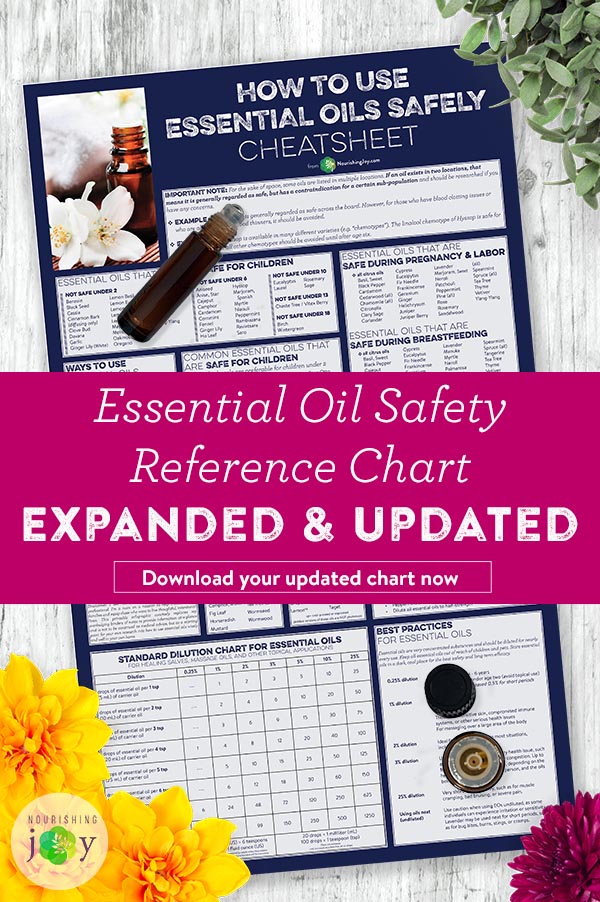


Remember: Essential Oils are Highly Concentrated
Did you know that it takes:
- 150 pounds of lavender flowers to make one pound of lavender essential oil?
- 256 pounds of peppermint leaves to make one pound of peppermint essential oil?
- About 50 roses to create just one drop of rose otto essential oil?
Those are extreme concentrates!
Here's another example: According to Lotus Garden Botanicals, one supplier of ethically-sourced, high-quality essential oils, here's how jasmine absolute is produced:
“Jasmine (Jasmine grandiflorum) absolute is extracted from un-bruised flower blossoms that are collected during the night when flowering occurs. The beautiful blossoms are far too delicate to process with steam distillation whereby the complete aroma of the flower is lost. To put this more into perspective, the same applies to grandiflorum as to its cousin sambac with approximately 8,000 carefully hand-picked blossoms being required to produce 1 gram (about 1 mL) of Jasmine grandiflorum absolute.”
Just think…. all those botanical compounds are distilled and concentrated into each drop of essential oil – and now we're rubbing and eating and inhaling those drops! It's important to keep in mind just how concentrated essential oils can be.
Essential Oils Should Be Properly Diluted
Because essential oils are so very concentrated, essentials oils should very rarely be used “neat” (undiluted). Doing so can cause irritation or allergic reaction.
Instead, add them to lotion or massage oil or other carrier oil before rubbing them on your skin. There's a dilution chart listed in the infographic above, as well as the proper dilution ratios for babies, children, pregnant women, etc.
As a general rule for adults, essential oils should be diluted in a carrier oil such as coconut oil or jojoba oil in a 2-3% solution. For children above six, a 1% dilution is sufficient. For one teaspoon of carrier oil, that's 2-3 drops for adults and 1 drop for children.
One safe way to test your body's reaction to any essential oil is to rub a small amount, diluted, on the inner part of your arm near the elbow and observe for any reaction.
Using Essential Oils on Babies and Children
This is one area of essential oil use that is most widely misused! In fact, the misconceptions and misinformation swirling around how to use essential oils on babies and children is what first drove me inspired me to create our Essential Oil Safety Cards – I wanted parents to have comprehensive, easy-to-read information ready at hand for when they were using essential oils on their kids!
I also moved all the information that was once here about how to use essential oils safely with babies and children and moved it (and VASTLY expanded it) into its own resource. It includes a searchable database, an at-a-glance list of which oils are safe at which age, where to find ethical sources, and what each oil is good for (even for adults).
See the Safe Essential Oils for Babies & Children guide here.
Essential Oils During Pregnancy and Breastfeeding
Extreme care should be used when taking essential oils while pregnant or nursing.
Oils should be completely avoided during the first trimester, both because there is evidence that essential oils can cross the placenta and because a number of essential oils can cause either contractions or blood clotting, which during early pregnancy would likely cause miscarriage. Also, many women have a highly-sensitized sense of smell during the first trimester and many essential oils would be overwhelming.
The one exception to this would be if you discover a certain scent that helps alleviate morning sickness. Lemon, peppermint, lavendar, and mandarin can be diffused or wafted for very brief intervals of time for nausea relief. Ask your doctor if you have any conditions that would mandate avoiding these oils completely during this time.
During the second and third trimesters, essential oils may be used sparingly and at half-dilution.
During labor, essential oils may be used for aromatherapy to help manage pain and encourage greater focus, as well as oils like clary sage may be used to induce labor if applied by a midwife or attending doctor. Avoid adding essential oils to a birthing tub, however, as the oils will float on the top, which can irritate the baby's skin, burn the baby's eyes, or inhibit proper respiration as he or she emerges from the water.
During breastfeeding, a number of oils should be used sparingly or avoided, but in general, most properly diluted oils are acceptable. Peppermint essential oil should be avoided because there is strong evidence that it can inhibit milk production.
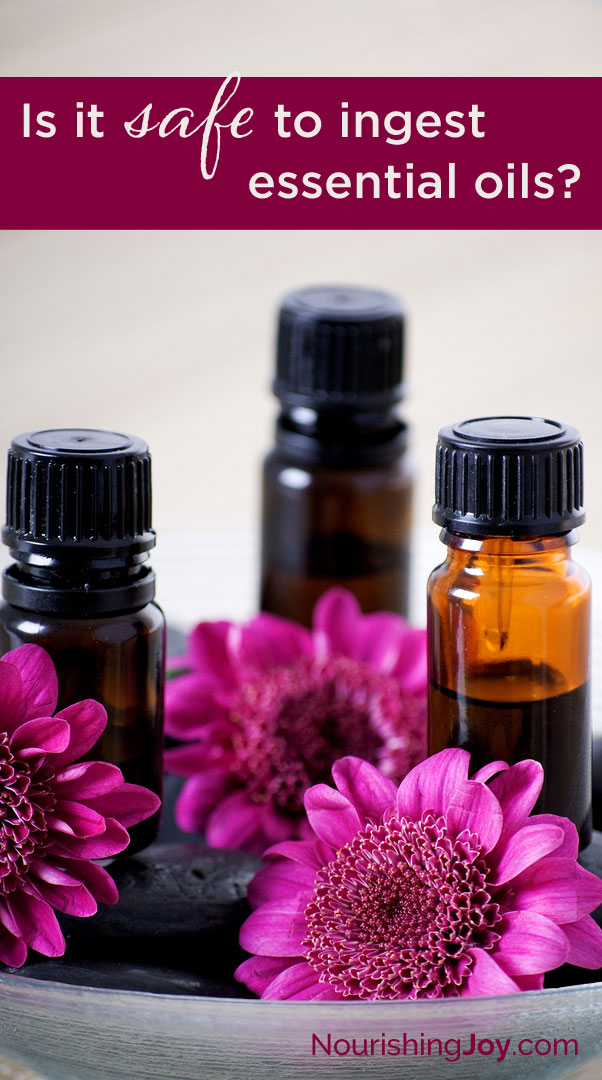


Is it safe to ingest essential oils?
This is a highly contentious issue, so I'll just give one quick quip.
Remember how I said at the beginning of this article that essential oils are pharmaceutical-grade medicines? And that they're known for being antibacterial, antiviral, and so on?
Well, think of this: in conventional medicine, what do we take when we need something antibacterial or antiviral? We take an antibiotic or a viral remedy! And what do antibiotics do? They wipe out the infesting bacteria, along with the good bacteria, in order to stop the ill invasion on our bodies. That's why you usually need to take a large dose of probiotics during and after a round of antibiotics in order to repopulate your gut with all those billions of healthy, happy bacteria.
The same is true for essential oils. They are not discriminatory when it comes to bacteria, either, so they need to be used with as much caution and intentionality as a conventional antibiotic.
And this is important:
The human gut contains a diverse eco-system made up of trillions of bacteria, comprising over 400 species, all of which are essential to our overall well-being. And while we're constantly learning more about the roles all these various bacteria play, we do know that the health of our gut drastically affects our overall health AND that imbalances in the gut exhibit body-wide, often as problems in the skin, nervous system, and even as behavorial issues.
By no means am I saying that essential oils shouldn't be taken internally! I'm merely saying that they should not be taken lightly or on a whim. When taken under the care of a trained professional, these compounds can powerfully assist healing if used properly, but can inflict organ damage, exacerbate allergic reactions, and alter hormones – in addition to effecting critical long-term gut health – if misused.
Essential oils are a huge gift for those of us who want to treat and heal our families with natural, effective, safe remedies. However, with great gifts come great responsibility, in this case to properly steward the potent natural remedies we have at hand.
Here's to your long-term health and the health of your family!
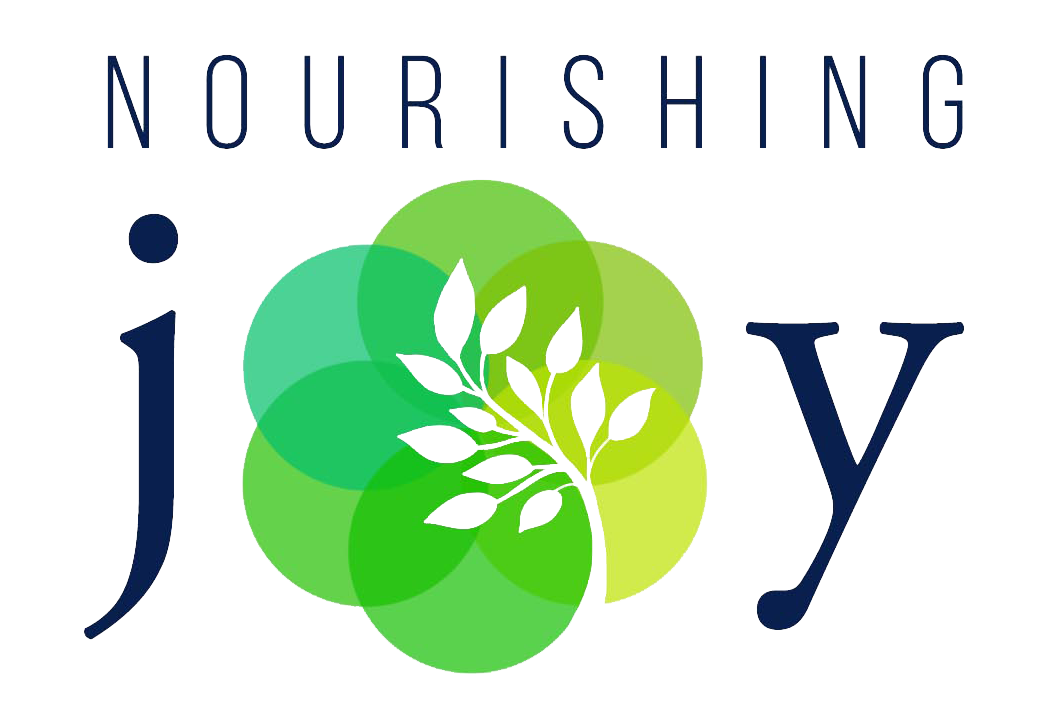
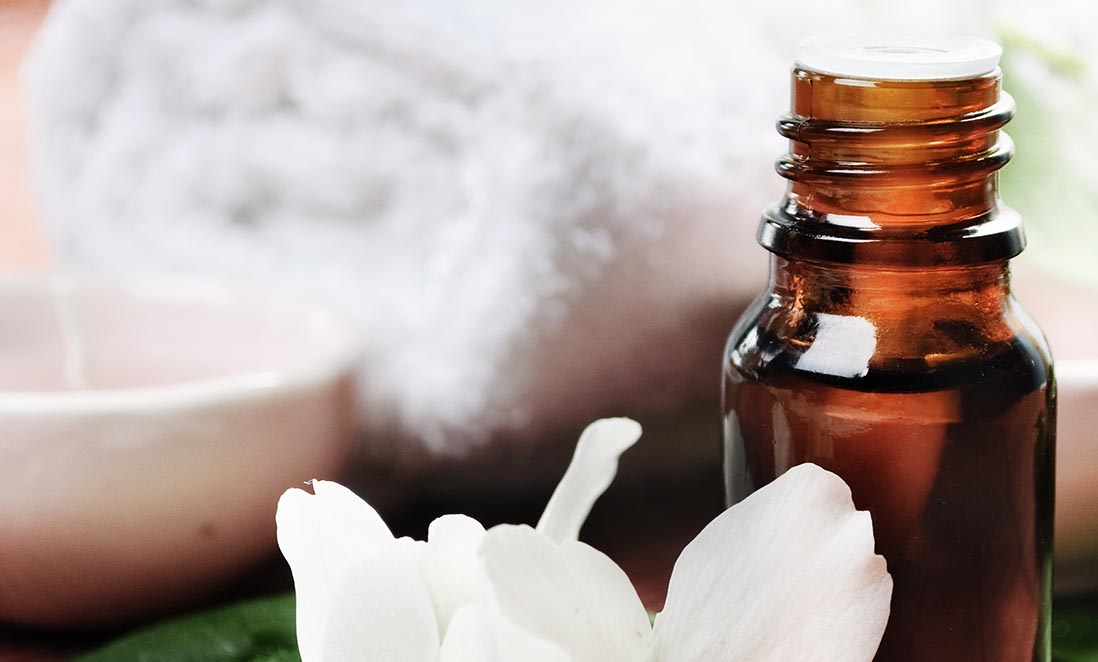



Im so glad I found this, thank you! I was in the process of compiling the same information. I even had the binder full of papers:)
Thanks for the information but i was just wondering if there is another way to see the cheatsheet? It’s really small..
Yes! It’s designed to be printed, so just click the picture to download it and then you can either read it in a PDF reader or print it out and read it on paper (it’s legal-size).
I hope that helps!
Could you be sending a copy of the Essential Oils?
I’m a bit confused by your safety chart. You’ve listed several of the same oils as safe during breastfeeding and also to avoid during breastfeeding. Can you clarify which are safe and which should be avoided?
Also, does diffusing peppermint also inhibit milk production, or is it just internal and typical usage?
Thank you!
Nursing Mama & New Oiler 🙂
Those are great questions!
Essentially, any oil listed under the “Avoid During Pregnancy, Labor and Breastfeeding” section are oils that should be avoided during that entire period – pregnancy, labor, and while breastfeeding.
HOWEVER, the 2-3 oils (cedar, juniper, and was there another?) that are ALSO listed under “Safe While Breastfeeding” are oils that should be avoided during pregnancy and labor, but are considered safe while breastfeeding. I included them in this section because it was the only way to list them as verboten during pregnancy and labor.
I agree it’s a bit confusing, so the next time I update the chart, I’ll see if I can figure out a way to clarify that further.
As for the peppermint, topical and internal usage are definitely to be avoided because they inhibit milk production (unless that’s what you NEED and in that case talk to a ICBLC), and yes, diffusing can have that effect as well. Some women don’t see a difference, but if you have any supply issues at all (like I did with my babes), avoiding it altogether is best.
Also, here’s a lovely article that I find helpful: http://www.justbreastfeeding.com/increasing-breastmilk/essential-oils-breastfeeding-2/
So, I hope that helps!
This is great! Thank you so much for including so much info in an easy to read and print off manner!
Hi there! You have helichrysum listed in both the “avoid while pregnant” section and the “safe to use while pregnant section.” I have been using a low dilution in my second and third trimester and would love some clarification on that. Also it’s confusing to have generic “chamomile” listed in the “avoid while pregnant” section and then include the specific safe ones in the “safe for pregnancy section.” It might be helpful to list which specific chamomile is unsafe in the “unsafe for pregnancy” section. Thanks for the info!
Yes – I hear you. I’m sorry for the confusion! In trying to compile the pregnancy, labor, and breastfeeding into one section (since so many of the oils overlap and DO apply to all three situations), I fear I left a few things unclear.
As for the helichrysum, it is generally regarded as very safe across the board – for babies, for children, for pregnancy, for breastfeeding, even used neat for sports injuries. So if you’re already using it, I wouldn’t worry about it at all. The only reason I list it in the “unsafe” section as well is for a very small percentage of the population: because it can act as a blood thinner, it may affect placental blood flow if you use it liberally, so those already at risk for miscarriage may want to avoid it. But used in appropriate amounts during a healthy pregnancy, it should be just fine.
And as for the chamomile, “chamomile” is listed generically in the “avoid while pregnant” section because all chamomiles should generally be avoided during pregnancy, ESPECIALLY in early pregnancy if there is any history of miscarriage, but German chamomile and Roman chamomile have been shown to be safe during breastfeeding. This doesn’t mean Moroccan chamomile or others are not, merely that those two are.
So, I hope that clarifies things a bit!
This resource is wonderful! Thank you!
I’ve gotten some advice for using some oils to help with heartburn, detox, etc…but I can’t ever find a BRAND that specifies that it’s ok to consume. Can you please offer any advice? Are you aware of a certain brand? Is there a certain “type” of oils that I should be looking for?
Goodness. Those are GREAT questions, but there are SO many variables to consider for SAFE ingestion, the only way to get a trustworthy answer that is right for YOU and your body’s makeup and chemistry would be to consult a certified aromatherapist or other professional. I’m sorry that’s not a neat and tidy answer, but when an oil will affect you differently according to how your blood clots, whether you’re pregnant, if you have high (or low) blood pressure, whether you’re taking any medications, if you have a mood-affecting chemical imbalance, if you have an over-active thyroid, etc, then there is no tidy answer. 🙁
Here are two links to possibly help you find an aromatherapist in your area:
https://www.naha.org/find-an-aromatherapist
https://www.alliance-aromatherapists.org/connect-with-aia-2/find-an-aromatherapist/
Good luck and I hope the essential oils help you tremendously! <3
Thank you so much for your response. And more importantly thank you for the work you do!
It won’t let me download the pdf is there someplace else I can see it clearly
Try this image-only link: https://nourishingjoy.com/wp-content/uploads/2015/09/essential-oil-safety-cheatsheet-updated.jpg
I hope that helps! 🙂
It worked ! Thank you
Excellent. 🙂
I need clarification on the math…..on the chart it lists tsp as being 5 ml, 20 drops = 1 milliliter (mL)
60 drops = 1 teaspoon (tsp). shouldn’t a tsp have 100 drops? Thanks
You are absolutely correct!! 1 teaspoon does indeed equal just shy of 100 drops, so I’ve gone back through all my original sources to find my original error and realized one of them was WRONG! Thus, I’ve updated the chart. 🙂
Thanks for your careful observation and a great question!
Wonderful!! Thank you. Next time you update, it would be great to deferinciate bewteen phototoxic oils based on extraction method since some citrus oils are not phototoxic, depending on how they are extracted (cold pressed or co2).
Love this and defitnitely sharing!
YES, you are so right. Lemon and lime are listed as cold-extraction on the chart, but I tried to get all of the oils on there and at a 4 point font, it just became a mess. 🙁
I am impressed. So much misinformation out there. I think you are one of the first bloggers I have read that has paid attention to safety. Thank you
Thank you for this excellent, balanced information!
Thank you, very informative. You sounds like one who knows what she’s saying.
I have tried many times over the last few hours to download and print this off. I have yet to receive this in my e-mail. Help.
Out of curiosity, have you checked your spam folder? I just dug deep into our e-mail system and it looks like you’ve received seven e-mails from us over the last three weeks, so obviously something isn’t working properly somewhere! 🙁
Regardless, I just sent the chart to you again manually – so if it’s not in your spam folder or buried in your inbox, contact me at kresha@njbeta.wpengine.com and we’ll make sure you get it one way or another! 🙂
I hope that helps!
Kresha
Thank you for your website and I do so want a hard copy of your chart.
Unfortunately, nothing happens when I “click”.
Please send it as an email because I want to mount it on my wall as a reference!!
Since you included your e-mail when you left your comment, I’ve just sent you the chart. 🙂
Don’t hesitate to drop a note to support@nourishingjoy.com if you don’t see it within the hour!
Thank you I love this chart it helps a lot. I have a almost 6 week old baby boy and am currently (attempting) to do a bunch of research for essential oils for babies as well as for me while I’m nursing. Funds are very tight so I’m trying to do the whole binder deal and make my own reference guide from stuff I find especially from the Internet (free is essential, pun intended), HOWEVER, I’m having a lot of trouble finding good guides, references and recipes. Would you mind giving me some resources I could start with and maybe good topics and keywords to research? I would really appreciate it. Again, thank you. This guide has been the most helpful to me that I’ve found.
I’m glad the chart is helpful! As for keywords, I think you’ve mentioned all of them in your question, so you’re already on the right track.
“safe essential oils for babies”
“safe essential oils for children”
“essential oil recipes for _______” (and of course, cross reference any oils in any blend recipes you find with the list of safe essential oils for babies ESPECIALLY since your sweet babe is so new!)
Good luck!
Thank you kresha for this info. And sharing your talent I like it
I do love essential oils..you give a lot of advise how to use it properly thats so important to me. My curiosity about essential oils are widen now..
Thank you Keesha for sharing such great insight from your experience. One question, how do you know what brand of oil to use? There are many out on the market. I hear doTERRA is really good. But do you think it would be better to use something “cheap-er” from the grocery store for my DIY projects and use the high quality stuff for my family(personal health)?
Subcription to your newsletter was one of the best things to happen to me!!
Mayra Cepeda
Mayra,
Oh, I’m so glad! And actually, I have an article discussing *exactly* this question: https://nourishingjoy.com/how-to-choose-best-essential-oil-brand/
(And by the way, yes, I do exactly what you’ve suggested: use the less expensive brands for recipes where I use the essential oils heavily and they won’t be in direct contact with skin or breathed in directly (such as in laundry detergent), and I reserve the more expensive brands for times when I use them more sparingly, such as diffusing or in a vapor rub recipe or skin balm. However, price is not always an indication of an oil’s quality, so at that point, I’m deciding merely on replacement cost for when I use an oil heavily.)
I hope it’s helpful!
The printable safety sheet is amazing! It is a little ink heavy and it looks like it will be difficult to read when I print it though. Would I be able to be e-mailed a copy that is in an image form so that I could blow it up to fit the whole page? Also would you be able to send me the references you used to find this information? I’m giving a presentation on essential oils for pharmacy school and I just want to make sure that I get the right information! Thanks in advance!
Thank you! I’m glad it will be helpful. 🙂
This version *is* ink-heavy – and YES, it’s in a PDF format that you can either print on a full legal-size page or zoom in on a mobile device or computer as much as you like – but after downloading it, you’ll receive a much more ink-friendly version in about a week. (Write support@nourishingjoy.com if you’re needing a copy faster than that and we’ll figure something out.)
As for references, they’re all on the print-out itself, so yes, you’ll receive those as well.
Have fun and good luck!
Edited to add: I just checked and you’ve been sent all the various files, but none of them appear to be read or received on your end. If you haven’t received them, would you PLEASE drop a note to our support desk and we’ll make sure you receive them ASAP! It looks like we’ve sent you four e-mails you haven’t received and I want to make sure you get what you’ve requested!
Thanks for the great information!
I just used some diluted ginger oil that my sister gave me, for ongoing pain in my leg from breaking it 3 years ago. It worked almost right away!
The oil came in the tinyest sample bottle I’ve ever seen, so there’s one or maybe two applications left. When I looked it up from my favorite company, they only offer the CO2 extract. As I understand, it’s safe for aromatherapy and topical use, but is it safe for ingestion?
Im just starting in learning about essential oils. I think the knowledge that they are toxic to cats even fatal should be a first alert in this day and age of animal lovers. Thank you for this guide it will be very helpful to me.
There are only a FEW essential oils that are toxic or fatal to cats. Some are very beneficial! That’s why I include them on the chart – and you’re right. We all need to know which oils are which, whether it’s cats, dogs, babies, or anyone else who relies on us for their safety and well-being. <3
I am unable to click on the chart and enlarge it. It says to enter my name and email address and it will be sent to me. I just wanted to look at the chart.
Hi, Connie!
Due to the amount of information on the chart and its size, the only way to zoom in and look at it is to download it. Also, that way anytime the chart is updated, you’ll get an updated, proper copy (as well as a more ink-friendly version).
I hope that helps!
Kresha
This resource is wonderful! Thank you for creating it!
So is Helichrysum safe or not safe while pregnant? You have it on both lists.
This is an amazing guide. I have a book that I use to see what oils can be used together too!
Thank you
Hi, the download button didn’t work for me.
Definitely drop us a line at support@nourishingjoy.com and we’ll make sure you receive it. ?
The printable safety sheet is amazing! It is a little ink heavy and it looks like it will be difficult to read when I print it though. Would I be able to be e-mailed a copy that is in an image form so that I could blow it up to fit the whole page? Also would you be able to send me the references you used to find this information? I’m giving a presentation on essential oils for pharmacy school and I just want to make sure that I get the right information! Thanks in advance!
If I’m using multiple oils in 2 tbsp of carrier oil, do I still use 15 drops per oil?
No, the 15 drops should be the TOTAL number of drops, even if multiple essential oils are used. 🙂
Definitely drop us a line at support@nourishingjoy.com and we’ll take care of you. 🙂